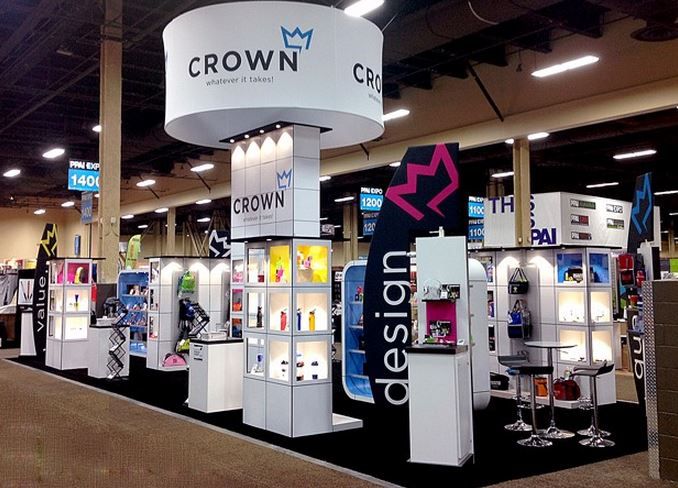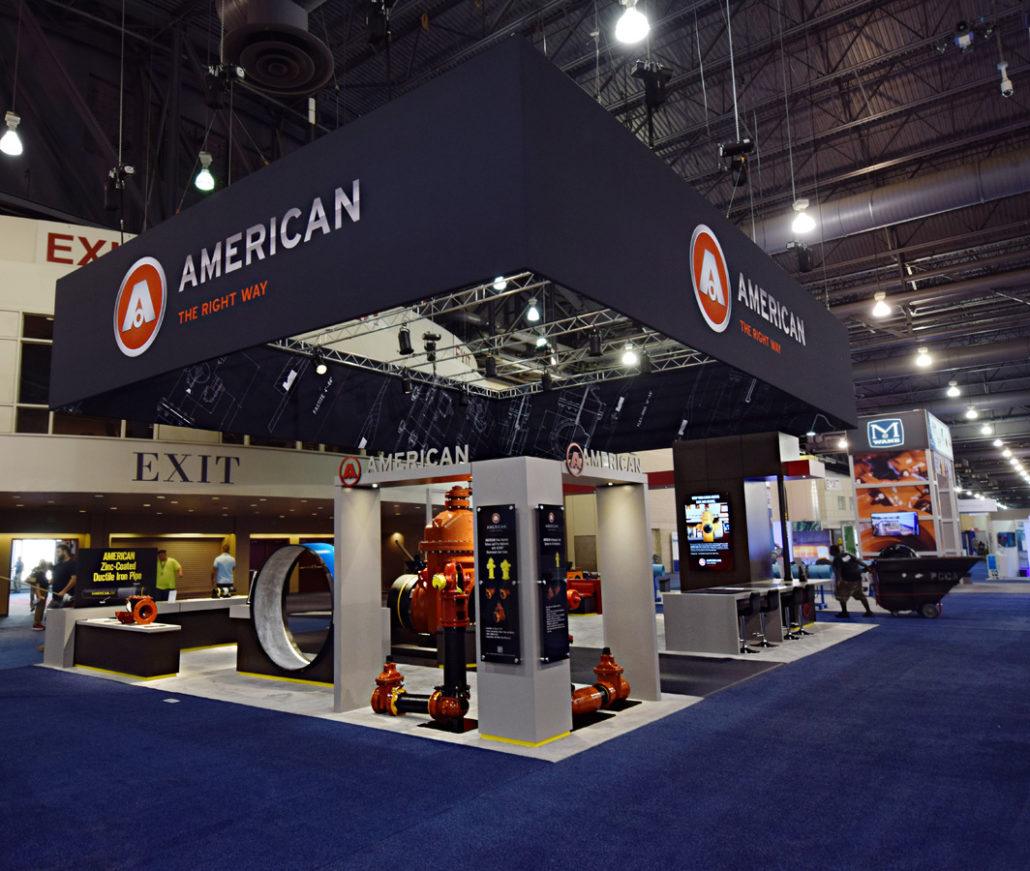Tips for Hosting a Successful 20×20 Exhibit
You’ve just landed your dream job as the Marketing Manager at a local company. You’re thrilled to be in charge of all the campaigns and marketing initiatives, and you’re ready to make your mark. But then it hits you: you have 6 months to plan and execute a 20 x 20 booth design at a major trade show.
It’s a daunting task, but don’t worry – this guide will walk you through every step of the way to ensure your 20×20 tradeshow display is successful.

Here are the key steps to consider when planning a 20×20 trade show booth:
Choose Your Trade Show Carefully
Choosing the right trade show to attend is crucial for the success of 20×20 exhibits. It’s important to choose a trade show that is relevant to your industry, as it will give you access to potential customers and partners who can provide valuable leads and information.
Trade shows also serve as an opportunity to network and build relationships with other companies in your field, helping you gain valuable insight into the current market trends and practices.
Additionally, it’s important to select a trade show that aligns with your company’s mission and goals. This will ensure that you make the most out of your 20×20 exhibit by targeting the right audience for your product or service.
Furthermore, attending popular trade shows allows you to compare yourself against competitors in terms of presentation, booth design, marketing strategies and post-show follow up tips.
Finally, selecting a quality location for your 20×20 exhibit is essential. When choosing a venue for your 20×20 exhibit, bear in mind factors like audience size, target market demographics, transportation access and parking availability.
All these aspects contribute significantly towards creating an effective 20×20 display that maximizes visibility and engagement at the event.
By taking the time to carefully select the right trade show based on these considerations, you can be sure that your 20 x 20 conference booth layouts will be successful in achieving the varied objectives – whether they include generating new leads; launching a new product or service; or simply gaining brand recognition among potential customers.
With careful planning and preparation, you can ensure that your 20×20 exhibit meets all of its goals and provides maximum return on investment.
Read the Show Exhibitors Manual
Reading the Trade Show Exhibitors Manual is an essential step in planning a 20×20 exhibit. The exhibitors manual offers detailed information on all the schedules, requirements, rules and regulations of the show.

It also provides a comprehensive list of all the services offered by the trade show organizers, including booth design and setup, audio-visual equipment rental, catering arrangements and more.
By reading through the exhibitors manual, you can gain a better understanding of what is allowed and forbidden at the trade show. This will help you create an effective 20×20 display that meets all of the guidelines set by the show organizers.
You can also use this information to inform your decisions about booth design and marketing strategies to ensure maximum visibility for your 20×20 exhibit.
Furthermore, the exhibitors manual may contain useful tips and advice from experienced exhibitors who have previously taken part in successful 20×20 exhibits.
Reading through these suggestions can be invaluable in developing an effective plan for your own 20×20 display. For example, experienced exhibitors might provide advice on how to maximize customer engagement or highlight key features of products or services through creative booth design ideas.
Apart from providing helpful guidance for new 20×20 exhibitors, reading through the exhibitor’s manual can also serve as a reminder of important deadlines that need to be met in order to ensure smooth operation during trade shows.
This includes confirming shipment instructions; scheduling staff training; reviewing health & safety protocols; as well as ensuring compliance with insurance requirements and other applicable regulations before setting up your 20×20 display at the event venue.
In conclusion, taking time to read through the trade show exhibitor’s manual is essential for success when planning 20×20 exhibits at major shows. Not only does it provide all necessary schedules and requirements for attending a trade show, but it also serves as a useful resource full of tips and suggestions from experienced 20×20 exhibitors which can help new marketers create an effective plan for their own 20×20 displays.
Establish Goals for the Show
Establishing goals for an upcoming 20×20 trade show is essential for success. These goals serve as a roadmap to guide exhibitors towards creating a successful 20×20 exhibit which maximizes visibility and engagement at the event.
Also, setting clear objectives for a 20×20 display helps exhibitors stay focused on key elements of their plan – such as budgeting, booth design, marketing strategies and post-show follow up tasks – which are necessary for achieving the desired outcomes.

When creating goals for your 20×20 display, it is important to consider a wide range of factors. These include the target audience; the size of the 20×20 exhibit space; the type of products or services being showcased; as well as the competition and previous 20×20 booth designs.
Additionally, you should take into account any unique opportunities that may arise during the trade show – such as speaking engagements or special promotions for visitors who visit your 20×20 display.
By establishing clear goals for a 20×20 trade show exhibit, you can create an effective plan of action to achieve the desired results. This includes developing a budget; designing an attractive 20×20 booth; creating marketing strategies which utilize digital and traditional tactics; as well as setting up post-show follow up tasks to engage with customers after the event.
In addition, you should use examples of successful 20×20 exhibits to inspire your own 20×20 display and get creative ideas on how to stand out from the competition.
Typical goals to consider include:
1. Generate brand recognition among potential customers
2. Increase sales and generate more leads
3. Build strategic partnerships with key industry players
4. Launch new products/services to the market
5. Gather customer feedback through surveys or interviews
6. Connect with influencers in the industry
7. Network and form business relationships with other exhibitors
8. Promote upcoming events, such as webinars or seminars related to the company’s product offerings
9. Demonstrate expertise in relevant topics by hosting workshops at the trade show venue
10 Improve customer service delivery by engaging directly with existing clientele
Put Your Plan in Writing
Writing down a plan for your upcoming trade show is essential for success. Not only does it help exhibitors stay focused on key elements of their plan, but it also serves as an invaluable resource which outlines all necessary schedules and requirements for attending a trade show.
Additionally, having a written plan can help ensure that all tasks are completed in time before the event starts and maximize visibility and engagement during the 20×20 display.
Set a Budget
When planning a 20×20 trade show booth, it is important to determine how much you have available to spend. This budget should include items such as shipping, display materials and marketing collateral.
To best manage your 20×20 exhibit budget, it is advised that you create a list of all necessary items which must be purchased in order to set up the 20×20 booth at the event. Additionally, research the cost of each item prior to purchasing them so that there are no unexpected expenses or delays when setting up the 20×20 exhibit space.
Furthermore, make sure not to overlook any hidden costs associated with displaying 20×20 exhibits at major shows – including insurance fees for certain types of displays; electrical setup fees; and venue rental charges for additional equipment or amenities used during the 20×20 display period.
It is also advisable to select an affordable but reliable vendor who can provide quality materials your exhibit needs within your price range. Finally, if possible try negotiating discounts on bulk orders such as trade show give-aways, which will help keep overall costs down for future shows as well.
Select a 20×20 Exhibit Design
Choose a design that is in line with your company’s aesthetic and will stand out among other trade show displays at the show. Keep in mind, 20×20 booths are typically divided into four main sections – storage, meeting/demonstration area, product display and reception area.
20 x 20 booth ideas should be designed to attract attention and engage potential customers. You can do this by utilizing design options such bright colors, large displays or interactive elements in the 20×20 display area. Components could include touchscreens, product demonstrations, etc.
Don’t hide! Your brand should not be a secret. 20 20 exhibits should also feature your company logo prominently to ensure brand recognition among potential customers. Consider using customized hanging signs, or branded towers or custom printed flooring with your branding.

Be sure to include all needed accessories in your design, such as shelves, monitors, furniture for the meeting areas, etc. In addition, 20×20 displays should be easy to navigate and clearly organized. This will make it easier for visitors to find what they are looking for and increase the chances of them engaging further with your 20×20 trade show booth.
Prepare Marketing Materials
Develop promotional materials that will help you reach the right audience at the trade show. This could include brochures, flyers or business cards — whatever is best suited to your brand and target market.
Be sure your exhibit space includes company branded materials such as banners and signage to create an eye-catching display at the event. You may also want to include branded give-away items for visitors to bring home.
Pre-Promote Your 20×20 Booth
Before the trade show, one of the most important tasks is to promote your investment in the 20×20 exhibit booth. This can be done many ways, including both press releases and social media campaigns.
Press Releases: To get the attention of potential customers and generate more interest in your 20×20 booth, it is recommended that exhibitors create press releases and send them out to local newspapers, radio stations, and online outlets.
The press release should include key information about your 20×20 display such as the location, date, time, and what visitors can expect when they visit your 20×20 exhibit space. Additionally, press releases should feature high-resolution images of your 20×20 booth design which will help create a strong visual impression on readers.
Social Media: Social media can be a great way to spread awareness of your 20×20 exhibit space before and during the event. Exhibitors should create several posts leading up to the event which highlight key features of their 20×20 exhibit space such as unique product offerings or interactive elements featured at their 20×20 display.
It is also encouraged to post live updates throughout the event with pictures and videos of any activities taking place in real-time so followers stay engaged with all developments related to your 20×20 display.
Schedule Meetings
During the show, take advantage of every opportunity to meet new potential customers or partners. Set up meetings in advance and use the 20×20 booth as a meeting point for all appointments. If appropriate, schedule one of your team to be a speaker for the convention at an industry meeting or product introduction forum.
Get Creative with Your 20×20 Booth
Make sure you take full advantage of all creative solutions available during when designing a your trade show exhibit – from incorporating custom lighting into exhibits which will draw attention from across crowded exhibition halls; using graphics which highlight key features of products; giving away promotional items with company logos; incorporating digital technology such as virtual reality (VR) or augmented reality (AR); setting up live demos and engaging activities which bring products alive – there are endless possibilities!
Follow Up After the Trade Show
Once the event has ended, follow up with contacts you made throughout the day and thank them for their time. This is also a great opportunity to discuss any potential opportunities that may have arisen as the visitors learned about the unique solutions your product or service offers.
Conclusion
20×20 exhibits are a great way to maximize visibility and engagement at trade shows. With the right planning, budgeting, booth design, marketing strategies and post-show follow up tips you can create an effective 20×20 exhibit that stands out from the competition.
Leverage creative solutions such as custom lighting, graphics highlighting key features of products, digital technology like virtual reality or augmented reality and engaging activities which bring your product alive to make sure visitors have a memorable experience with your 20×20 display.
Don’t forget to also take advantage of pre-promotion opportunities through press releases and social media campaigns before the event starts so more people know about your 20×20 exhibition space!

